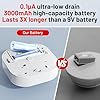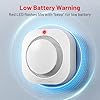A heat detector is a device that senses the presence of heat. Heat detectors are used in a variety of applications, including fire detection, process control, and security. There are two main types of heat detectors: point and line. Point heat detectors are designed to detect heat at a single point, while line heat detectors are designed to detect heat along a line.
1. Use heat detectors for early detection of fires.
in high hazard areas, such as boiler rooms, where a fire would be difficult to see.
2. Use heat detectors where there is a potential for a fire to smolder for some time before igniting.
3. Use heat detectors in areas where fumes or smoke from a fire would inhibit the visibility of the fire.
4. Use heat detectors in areas where sprinklers are not installed or where the water supply for sprinklers is inadequate.
Contents
The different types of heat detectors and when to use them
There are two main types of heat detectors- rate-of-rise and fixed temperature.
Rate-of-rise heat detectors are designed to detect an increase in temperature over a period of time. They are best used in areas where there is a potential for a rapid-fire to start, such as in a kitchen or a laboratory.
Fixed temperature heat detectors are designed to activate at a specific temperature. They are best used in areas where there is a potential for a slow-burning fire to start, such as in a storage room or an office.
How do heat detectors work?
Heat detectors are devices that are used to detect the presence of heat. There are two main types of heat detectors: those that measure the temperature of the air, and those that measure the heat radiation.
Air-temperature heat detectors are the most common type of heat detector. They work by measuring the temperature of the air around them. If the temperature of the air rises to a certain level, the heat detector will activate.
Heat radiation detectors work by measuring the amount of infrared radiation that is present in the area. If the level of infrared radiation rises to a certain level, the heat detector will activate.
The benefits of using heat detectors
There are many benefits to using heat detectors, including their ability to detect fires quickly, their low cost, and their ease of installation. Heat detectors are also less likely to cause false alarms than smoke detectors, making them ideal for use in areas where smoke detectors would be impractical or difficult to install.
The limitations of heat detectors
There are several limitations to heat detectors that users should be aware of when deciding whether or not to use them. One such limitation is that heat detectors are not as sensitive as smoke detectors. This means that they may not detect a fire in its early stages when it is most easily extinguished.
Additionally, heat detectors are not able to discriminate between different types of fires, meaning that they will activate even if there is no danger of the fire spreading. Finally, heat detectors are subject to false alarms, which can be caused by factors such as cooking or sunlight.
How to properly maintain your heat detectors?
There are a few things you can do to properly maintain your heat detectors and keep them in good working condition. First, make sure to keep the detectors clean and free of dust and dirt. You can do this by gently vacuuming the detectors with a soft brush attachment.
If the detectors are very dirty, you can lightly wipe them down with a damp cloth. Just be sure not to get the detectors wet, as this can damage them.
Second, test the detectors regularly to ensure they are working properly. You can do this by using a heat source, such as a hair dryer, to simulate a fire. Hold the heat source close to the detector for a few seconds to see if the detector goes off. If it doesn’t, then you know there is an issue that needs to be addressed.
Finally, make sure to replace the batteries in the detectors as needed. Most heat detectors use 9-volt batteries, so you should check them every few months to see if they need to be replaced. By following these simple steps, you can help to ensure that your heat detectors are always in good working condition.
Tips for troubleshooting heat detector problems
There are a few tips to follow when troubleshooting heat detector problems:
- Check the power source. Make sure that the heat detector is receiving power from the correct source.
- Check the connections. Make sure that all connections are tight and secure.
- Check the wiring. Inspect the wiring for any signs of damage or loose connections.
- Check the sensor. Make sure that the sensor is clean and free of debris.
- Check the environment. Make sure that the heat detector is not in a drafty or damp location.
- Check the alarm. Make sure that the alarm is loud and clear.
- Check the batteries. Make sure that the batteries are fresh and that they are properly installed.
Summary
There are many different types of heat detectors, each with its own specific purpose. In general, though, heat detectors are used to detect the presence of heat, usually in the form of a fire. Heat detectors can be either fixed or portable, and they can be either ionization or photoelectric.
Ionization heat detectors work by detecting the presence of free ions in the air. These ions are created when heat causes a chemical reaction, such as the combustion of a fuel. Ionization heat detectors are usually used in areas where there is a lot of smoke, such as in a kitchen.
Photoelectric heat detectors work by detecting the presence of particles of soot or smoke in the air. These particles are created when heat causes a fire. Photoelectric heat detectors are usually used in areas where there is not a lot of smoke, such as in a bedroom.
Heat detectors are an important part of any fire safety system. They can provide early warning of a fire, which can help to save lives and property.



















